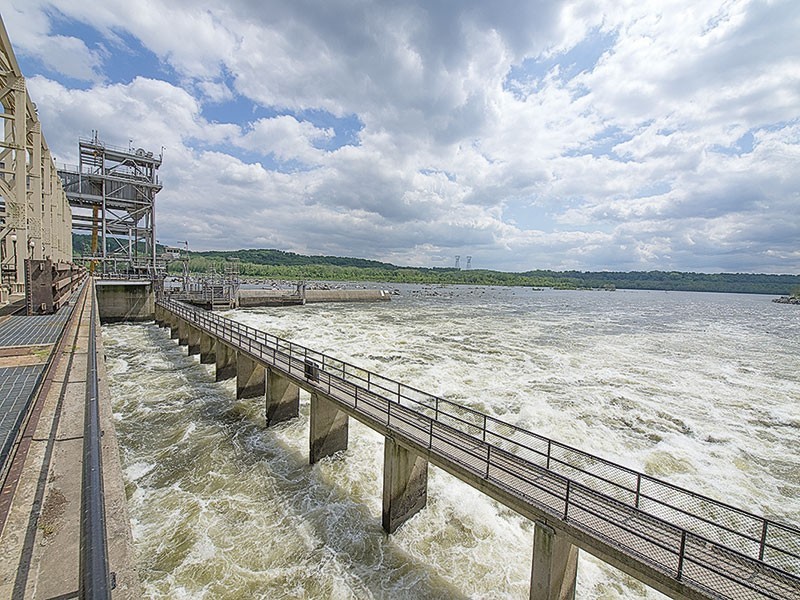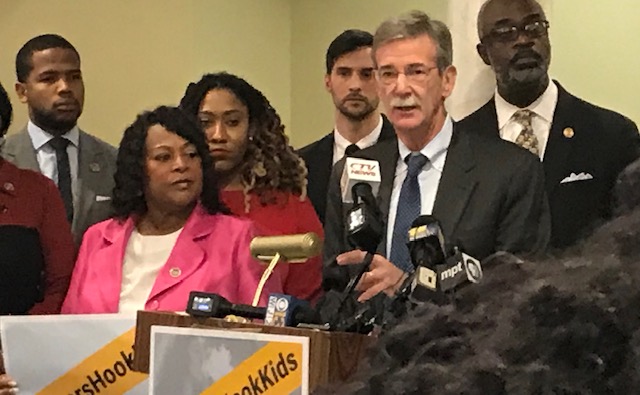By Timothy B. Wheeler
Bay Journal
Exelon Corp. could help restore the lower Susquehanna River and Chesapeake Bay by changing the way it generates electricity at Conowingo Dam, and still make a “healthy” profit, a pair of environmental groups reported this month.
The Chesapeake Bay Foundation and The Nature Conservancy released a study they jointly commissioned that finds that the Chicago-based energy company could easily afford to mitigate the impacts Conowingo is having on downriver fish habitat and water quality.
The study, conducted by Energy+ Environmental Economics of San Francisco, CA, for the Water and Power Law Group, concluded that the 94-foot tall hydropower dam generates enough revenue, depending on variations in flow and electricity prices, to give Exelon $27 million to $44 million annually in extra profits, beyond the industry norm. That provides sufficient “headroom,” the study said, for the company to take steps to reduce the downstream impacts of the dam and its operation.
The groups released the report ahead of a Dec. 5 public hearing in Bel Air on Exelon’s application for a state permit needed to continue operating the 90-year-old hydropower facility. The Maryland Department of the Environment is taking public comments until Jan. 15 on the company’s request for a water quality certification.
Exelon disputes estimates
An Exelon spokeswoman responded with a statement disputing the study’s estimates of the dam’s future revenues and profitability, saying they are based on “flawed assumptions and theories.” Deena O’Brien, the spokeswoman, said that the company is committed to being a good neighbor, but shouldn’t be held accountable for pollution passing through the dam.
“It’s important to note that Conowingo’s operations do not generate sediment,” O’Brien said. “Most of the sediment that impacts the Bay comes from upstream sources. As such, the regional sources of sediment across the basin should take joint responsibility for the issue, not a single company or entity.”
Exelon has already agreed to build a new fish lift and take other steps to improve the passage upriver for migratory shad, herring and eels, the populations of which have declined drastically since the dam was finished in 1928.
The Hogan administration and others have also called for Exelon to share in the costs of dealing with the buildup of nutrient-laden sediment behind the dam, which studies indicate pose a threat to Bay restoration.
“We are not looking to have Exelon be responsible for everything that is no longer being trapped because of the reservoir being full,” Alison Prost, Maryland director of the Bay Foundation, said in a conference call with reporters.
Rather, said Mark Bryer, the conservancy’s Chesapeake Bay director, the groups want Exelon to mitigate the dam’s impact in two different ways — by funding some pollution reduction measures elsewhere that would offset what’s now being passed downriver, and by altering the flows of water through the dam.
Sediment buildup
Studies have determined that sediment has built up behind the dam to the point that it traps little of what washes in from upstream, and that during storms and heavy rains, pulses of sediment, with algae-stimulating nutrients attached, are scoured out and washed downriver to the Bay. A major tropical storm, if it hits the region at the wrong time of year, could set Bay restoration efforts back by years, said Doug Myers, a foundation senior scientist.
Exelon’s operation of the dam is also causing up to 20-fold fluctuations in river flow – sometimes in the same day — as water is held back and then released to generate power during times of peak demand, the groups contend. Those variations disrupt the spawning of migratory fish and degrade habitat for their offspring, according to conservancy scientist Tara Moberg.
The groups are calling for dramatic increases in spring flow through the dam, which they contend should make the area downriver more habitable for spawning fish and their fry.
At the beginning of spawning season in March, the company releases water at the average rate of 3,500 cubic feet per second, Bryer explained. In Exelon’s application to renew its license to operate the dam, it has offered to boost that flow to 4,000 cubic feet per second. The conservancy, though, has called for a release rate of 25,000 to 30,000 cubic feet per second, which Moberg said is still roughly half of what river flows were like before the dam was built.
Cost of increasing flow
Adjusting river flows for the benefit of fish and not just electricity generation would cost Exelon between $3 million to $5 million a year in lost revenue, Moberg estimated. That’s on top of the $3 million to $6 million a year the company has projected it could have to spend on improving fish passage — which the groups say their study already took into account in estimating Exelon’s revenues and profits.
But, based on the financial study, the groups contend that Exelon could let the river flow completely unfettered through the dam and still make money.
Prost said the environmental groups haven’t settled on a figure for pollution mitigation yet, because officials with the federal-state Chesapeake Bay Program are still working to pin down estimates of how much phosphorus and sediment the dam is contributing to the estuary’s water quality problems. Those calculations should be finished shortly, she said, and the groups intend to submit a proposed mitigation cost by the comment deadline.
“More pollution will come through the Conowingo Dam and into the Bay than scientists previously calculated,” Foundation President Will Baker said in a release about the study. “Exelon has the responsibility and revenue to pay for its share of the solution.”
The public has until Jan. 15 to submit written comments. To do so, write Elder Ghigiarelli Jr., deputy administrator, Wetlands and Waterways Program, Water and Science Administration, Maryland Department of the Environment, 1800 Washington Boulevard, Suite 430, Baltimore MD 21230. Comments also can be emailed to elder.ghigiarelli@maryland.gov
twheeler@bayjournal.com
Bay Journal is published by Bay Journal Media, a 501(c)(3) nonprofit, to inform the public about issues that affect the Chesapeake Bay. A print edition is published monthly and is distributed free of charge. News, features and commentary are available free online at bayjournal.com. MarylandReporter.com, also a 501(c)(3) nonprofit news organization, is partnering with the Bay Journal by publishing one of its articles every Friday.





Recent Comments